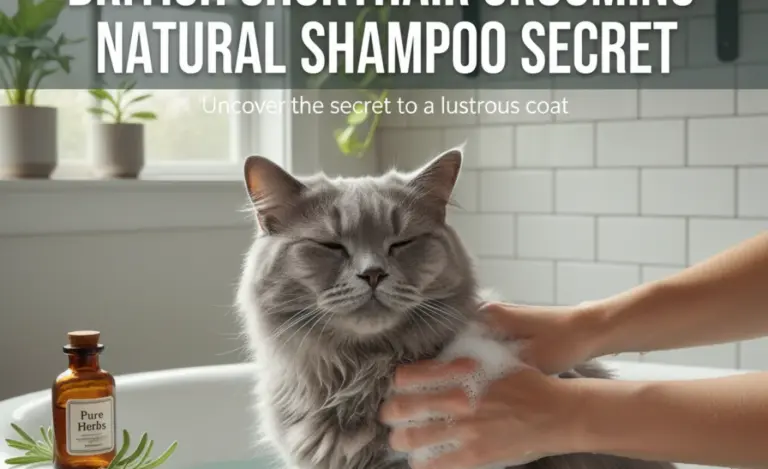British Shorthair Cat Hygiene Checklist: Easy Guide
Quick Summary: A happy British Shorthair is a clean British Shorthair! This checklist covers essential grooming: weekly brushing to manage shedding, regular teeth cleaning to prevent dental disease, occasional baths if needed, nail trimming every few weeks, and keeping those adorable ears clean. Follow this, and you’ll have a healthy, handsome kitty!
Bringing a British Shorthair into your home is like welcoming a fluffy, four-legged family member. These cats are known for their calm demeanor and stunning good looks. But, like all cats, they need regular grooming to stay healthy and happy. Many owners find the grooming routine a little overwhelming at first. Don’t worry! With a few simple steps, you can easily keep your British Shorthair looking and feeling their best.
This checklist breaks down everything you need to know about British Shorthair hygiene. We’ll cover brushing, dental care, bathing, nail trimming, and ear cleaning. Let’s get started!
British Shorthair Cat Hygiene Checklist: A Step-by-Step Guide
British Shorthairs are relatively low-maintenance cats, but regular hygiene practices are vital. Here’s a complete checklist to keep your feline friend in tip-top shape:
1. Weekly Brushing: Taming the Fluff
British Shorthairs have a dense, plush coat that requires regular brushing to prevent mats and reduce shedding. Aim for at least once a week, but more frequent brushing (2-3 times) during shedding season (spring and fall) is ideal.
Tools You’ll Need:
- Slicker Brush: Excellent for removing loose fur and detangling.
- Metal Comb: Helps to get deeper into the coat and check for mats.
- Deshedding Tool (Optional): Can be useful during heavy shedding periods, but use gently.
How to Brush Your British Shorthair:
- Start Gently: Let your cat sniff the brush and get used to it. Offer treats and praise to create a positive association.
- Brush in the Direction of Hair Growth: Use gentle, short strokes to avoid pulling or irritating the skin.
- Pay Attention to Problem Areas: Focus on areas prone to matting, such as behind the ears, under the legs, and around the tail.
- Use the Metal Comb: After brushing with the slicker brush, use the metal comb to check for any remaining tangles or mats.
- Reward Your Cat: End the session with more treats and praise.
Why is brushing so important?
- Reduces Shedding: Regular brushing removes loose fur, minimizing the amount of hair your cat swallows and reduces hairballs.
- Prevents Mats: Mats can be painful and difficult to remove. Regular brushing keeps the coat smooth and tangle-free.
- Stimulates Circulation: Brushing promotes healthy blood flow to the skin, which can improve coat condition.
- Bonding Time: Brushing can be a relaxing and enjoyable experience for both you and your cat.
2. Dental Care: Keeping Those Pearly Whites Healthy
Dental disease is common in cats and can lead to serious health problems. Regular dental care is essential for preventing tartar buildup, gum disease, and tooth loss. According to Cornell Feline Health Center, dental disease affects 50% to 90% of cats over the age of four years.
Tools You’ll Need:
- Cat Toothbrush: Use a toothbrush designed specifically for cats, as human toothbrushes can be too harsh.
- Cat Toothpaste: Never use human toothpaste, as it contains ingredients that are toxic to cats. Choose a toothpaste formulated for cats, often flavored with chicken or fish.
- Dental Wipes (Optional): Can be used for a quick clean between brushings.
- Dental Treats (Optional): Some treats are designed to help clean teeth as your cat chews.
How to Brush Your Cat’s Teeth:
- Introduce Slowly: Start by letting your cat lick the toothpaste from your finger.
- Gradually Introduce the Toothbrush: Once your cat is comfortable with the toothpaste, gently introduce the toothbrush.
- Brush Gently: Use small, circular motions to clean the outer surfaces of the teeth. Don’t worry about brushing the inner surfaces, as most cats won’t tolerate it.
- Focus on the Gumline: Pay special attention to the gumline, where tartar tends to accumulate.
- Keep Sessions Short: Start with short sessions (30 seconds) and gradually increase the time as your cat becomes more comfortable.
- Reward Your Cat: Always end with praise and a treat.
How Often Should You Brush?
Ideally, you should brush your cat’s teeth daily. However, even brushing a few times a week can make a big difference. If daily brushing isn’t possible, consider using dental wipes or treats to supplement your cat’s dental care.
3. Bathing: When a Wash is Necessary
British Shorthairs are generally clean cats and don’t require frequent bathing. In fact, over-bathing can strip their coat of its natural oils, leading to dry skin and a dull coat. Only bathe your cat when they are visibly dirty, have gotten into something sticky or smelly, or if recommended by your veterinarian.
Tools You’ll Need:
- Cat Shampoo: Use a shampoo specifically formulated for cats. Human shampoo can be too harsh and irritating.
- Towels: Have several towels on hand to dry your cat.
- Non-Slip Mat: Place a non-slip mat in the tub or sink to prevent your cat from slipping.
- Pitcher or Cup: Use a pitcher or cup to pour water over your cat.
- Grooming Brush: To brush your cat before and after the bath.
How to Bathe Your British Shorthair:
- Brush First: Brush your cat before the bath to remove any loose fur and mats.
- Prepare the Bathing Area: Fill the tub or sink with lukewarm water. Make sure the water is not too hot or too cold.
- Wet Your Cat: Gently wet your cat with the pitcher or cup, avoiding the face and ears.
- Apply Shampoo: Apply a small amount of shampoo and massage it into the coat, working from head to tail.
- Rinse Thoroughly: Rinse your cat thoroughly with lukewarm water until all the shampoo is removed.
- Dry Your Cat: Wrap your cat in a towel and gently pat them dry. You can also use a hairdryer on a low, cool setting, but be careful not to overheat your cat.
- Brush Again: Once your cat is dry, brush their coat to remove any tangles and restore its fluffiness.
Tips for a Stress-Free Bath:
- Start Young: If possible, get your cat used to bathing as a kitten.
- Stay Calm: Speak to your cat in a soothing voice and move slowly and gently.
- Make it Quick: The longer the bath takes, the more stressed your cat will become.
- Reward Your Cat: After the bath, give your cat plenty of praise and a treat.
4. Nail Trimming: Preventing Scratches and Overgrowth
Regular nail trimming is essential for preventing scratches on furniture and people, as well as preventing ingrown nails. How often you need to trim your cat’s nails will depend on their activity level and whether they have access to scratching posts. Generally, trimming every 2-3 weeks is sufficient.
Tools You’ll Need:
- Cat Nail Clippers: Use clippers specifically designed for cats. Scissor-type clippers or guillotine clippers are both good options.
- Styptic Powder: Keep styptic powder on hand in case you accidentally cut the quick (the pink part of the nail containing blood vessels and nerves).
- Towel (Optional): Some cats are more cooperative if wrapped in a towel.
How to Trim Your Cat’s Nails:
- Get Your Cat Comfortable: Start by gently handling your cat’s paws and toes. Get them used to having their paws touched.
- Extend the Nail: Gently squeeze the paw to extend the nail.
- Identify the Quick: Look for the pink part of the nail (the quick). You want to avoid cutting into this area, as it will cause pain and bleeding.
- Trim the Nail: Clip the sharp tip of the nail, being careful to avoid the quick. Angle the clippers slightly to follow the natural curve of the nail.
- Reward Your Cat: After trimming each nail, give your cat praise and a treat.
What if You Cut the Quick?
If you accidentally cut the quick, don’t panic. Apply styptic powder to the bleeding nail. The powder will help to stop the bleeding quickly. Talk to your vet if you are concerned.
5. Ear Cleaning: Keeping Infections at Bay
Regular ear cleaning helps to prevent ear infections and keeps your cat’s ears healthy. British Shorthairs are not particularly prone to ear infections, but it’s still a good idea to check their ears regularly and clean them when necessary. The RSPCA recommends checking your pet’s ears regularly for any signs of infection or mites.
Tools You’ll Need:
- Ear Cleaning Solution: Use a solution specifically formulated for cats. Never use alcohol or hydrogen peroxide, as these can be irritating.
- Cotton Balls or Gauze Pads: Use cotton balls or gauze pads to clean the ears.
How to Clean Your Cat’s Ears:
- Check the Ears: Before cleaning, check your cat’s ears for any signs of infection, such as redness, swelling, discharge, or odor. If you notice any of these signs, consult your veterinarian.
- Apply Ear Cleaning Solution: Gently lift your cat’s ear flap and apply a small amount of ear cleaning solution into the ear canal.
- Massage the Base of the Ear: Gently massage the base of the ear for 20-30 seconds to loosen any debris.
- Wipe Away Debris: Use a cotton ball or gauze pad to wipe away any debris from the ear canal. Only clean the parts of the ear that you can see. Do not insert the cotton ball or gauze pad too far into the ear canal.
- Repeat if Necessary: Repeat the process if necessary until the cotton ball or gauze pad comes out clean.
- Reward Your Cat: After cleaning the ears, give your cat praise and a treat.
How Often Should You Clean Your Cat’s Ears?
Generally, you only need to clean your cat’s ears when they appear dirty or have excessive wax buildup. For most cats, this will be every few weeks to every few months.
British Shorthair Hygiene Checklist: Summary Table
| Hygiene Task | Frequency | Tools Needed | Benefits |
|---|---|---|---|
| Brushing | Weekly (2-3 times during shedding season) | Slicker brush, metal comb, deshedding tool (optional) | Reduces shedding, prevents mats, stimulates circulation |
| Dental Care | Daily (or a few times a week) | Cat toothbrush, cat toothpaste, dental wipes (optional), dental treats (optional) | Prevents dental disease, tartar buildup, and gum disease |
| Bathing | Only when necessary | Cat shampoo, towels, non-slip mat, pitcher or cup | Removes dirt and odors |
| Nail Trimming | Every 2-3 weeks | Cat nail clippers, styptic powder | Prevents scratches and overgrowth |
| Ear Cleaning | Every few weeks to months (as needed) | Ear cleaning solution, cotton balls or gauze pads | Prevents ear infections and keeps ears healthy |
Recognizing Signs of Hygiene-Related Health Issues
Being vigilant about your British Shorthair’s hygiene also means knowing when something isn’t right. Here are some red flags to watch for:
- Excessive Shedding or Dull Coat: Could indicate poor diet, stress, or underlying health issues.
- Bad Breath or Inflamed Gums: Signs of dental disease requiring veterinary attention.
- Frequent Scratching or Licking: May indicate allergies, parasites, or skin infections.
- Ear Discharge, Redness, or Head Shaking: Suggests an ear infection or mites.
- Changes in Appetite or Litter Box Habits: Can be related to various health concerns, including dental pain or infections.
If you notice any of these signs, consult with your veterinarian promptly. Early detection and treatment can prevent minor issues from becoming major health problems.
Frequently Asked Questions
Here are some common questions about British Shorthair hygiene:
How often should I groom my British Shorthair?
You should brush your British Shorthair at least once a week, and more often during shedding season. Dental care should be done daily or a few times a week. Baths are only needed when your cat is visibly dirty. Trim their nails every 2-3 weeks, and clean their ears as needed (usually every few weeks to months).
What kind of brush is best for a British Shorthair?
A slicker brush is great for removing loose fur and detangling. A metal comb helps to get deeper into the coat and check for mats. A deshedding tool can be useful during heavy shedding periods, but use it gently.
How can I make grooming a positive experience for my cat?
Start slowly and gently, and let your cat sniff the tools. Offer treats and praise to create a positive association. Keep grooming sessions short and end with a reward.
My cat hates having their teeth brushed. What can I do?
Introduce teeth brushing slowly. Start by letting your cat lick the toothpaste from your finger. Gradually introduce the toothbrush. If brushing is too difficult, try using dental wipes or treats as an alternative.
Is it normal for my British Shorthair to shed a lot?
British Shorthairs have a dense coat and are moderate shedders. Regular brushing can help to minimize shedding. However, excessive shedding could indicate a health problem, so consult your veterinarian if you’re concerned.
What should I do if I accidentally cut my cat’s quick while trimming their nails?
Don’t panic! Apply styptic powder to the bleeding nail. The powder will help to stop the bleeding quickly. If the bleeding doesn’t stop, consult your veterinarian.
How do I know if my cat has an ear infection?
Signs of an ear infection include redness, swelling, discharge, odor, and head shaking. If you notice any of these signs, consult your veterinarian.
Conclusion
Maintaining a good hygiene routine for your British Shorthair doesn’t have to be a chore. By following this checklist and making grooming a regular part of your routine, you can help your cat stay healthy, happy, and looking their best. Remember to be patient, gentle, and always reward your cat for their cooperation. With a little practice, you and your British Shorthair can enjoy a lifetime of purrs and cuddles!



